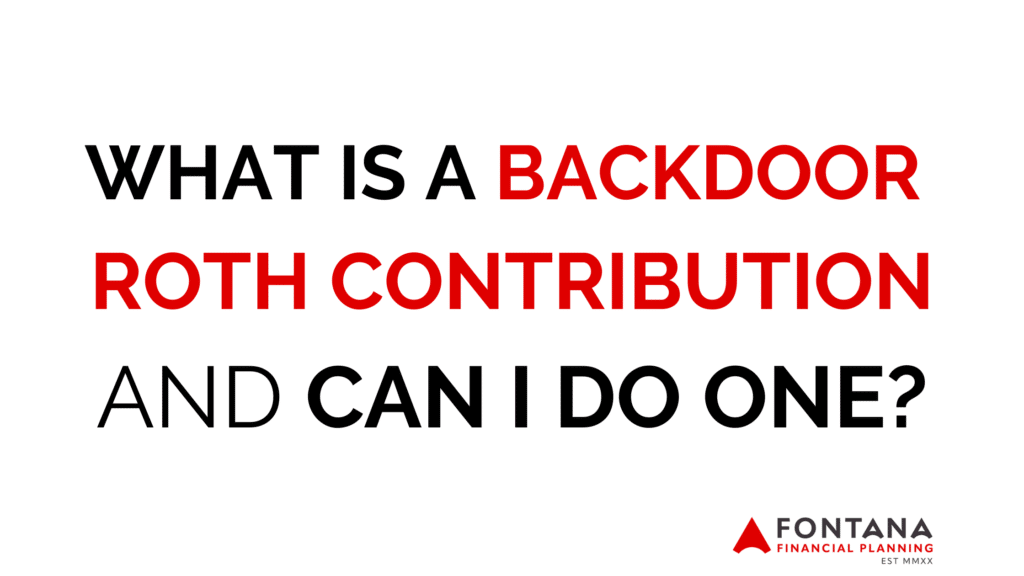When it comes to contributing money to a Roth IRA it can be relatively straightforward – depending on your filing status you can make a maximum contribution of $6,500 ($7,500 if over the age of 50) in 2023 if your modified adjusted gross income (MAGI) is below:
- Single – $138,000
- Married Filing Jointly – $218,000
- Married Filing Separately – $10,000
Once you eclipse that MAGI threshold – or if you’d like to contribute more than the phaseout allows – the way to do so is by completing a Backdoor Roth contribution. With the Backdoor Roth contribution strategy you are able to contribute up to the maximum annual amount regardless of your MAGI.
To understand how a Backdoor Roth contribution works we need to examine the difference between a deductible and non-deductible IRA contribution. When making a deductible IRA contribution, you can deduct the amount you’ve contributed from your income taxes for the year of the contribution, assuming you are below the income limit for making a deductible contribution.
The deductibility limits for an IRA are much lower than those of a Roth IRA contribution so if you are over the Roth contribution income threshold you can’t deduct an IRA contribution from your income taxes, thus creating a non-deductible basis within your IRA when you contribute. When a non-deductible basis is converted to Roth before any earnings have occurred there is no additional tax impact meaning if you follow the listed steps you are able to contribute funds to your Roth IRA regardless of your MAGI:
- Open a Traditional IRA and Roth IRA account in your name
- Contribute funds to the Traditional IRA account
- Convert funds from the Traditional IRA to Roth IRA account before any earnings have accrued (if earnings have accrued they will simply be taxed as income in the year of the conversion)
Before you begin taking the steps to complete the Backdoor Roth contribution let’s examine what may cause the strategy to not work. Due to what are called the ‘pro-rata’ withdrawal rules if you hold both deductible and non-deductible funds in your IRA, this strategy has additional tax implications and may not work. This includes any funds in a Traditional IRA, SEP IRA, or a SIMPLE IRA but not a 401(k).
Example: Tom has a SEP IRA with $93,000 and hears about the ‘Backdoor Roth’ from a friend who tells him he can still contribute to a Roth IRA despite his high income. Not understanding the nuances of the pro-rata rules, he contributes $7,000 to a newly established IRA and immediately converts it to a Roth – thinking there will not be any tax implication for doing so. Considering a SEP is part of the pool of funds the IRS looks at when determining pro-rata taxation, he has $100,000 in IRA funds and a $7,000 basis. When he completes his Roth conversion, only 7% of the converted amount is non-deductible basis meaning 93% – or $6,510 – is taxable as income this year (even though he is paying income taxes on the $7,000 he contributed) and he must ensure his CPA tracks his ongoing basis using form 8606 to avoid paying taxes twice on the remaining portion of the $7,000 he contributed.
Would you like to understand whether the content discussed in this post is appropriate for you and how it may fit in to your overall financial plan? Schedule an introductory phone call with our team here. Read more about Roth conversions here.
Disclosures: This case study is for illustrative purposes only. Individual cases will vary. Any information is not a complete summary or statement of all available data necessary for making an investment decision and does not constitute a recommendation. Prior to making any investment decision, you should consult with your financial advisor about your individual situation.
Unless certain criteria are met, Roth IRA owners must be 59½ or older and have held the IRA for five years before tax-free withdrawals are permitted. Additionally, each converted amount may be subject to its own five-year holding period. Converting a traditional IRA into a Roth IRA has tax implications. Investors should consult a tax advisor before deciding to do a conversion.
This strategy is not suited for every investor. Prior to making an investment decision, please consult with your financial advisor about your individual situation.
The foregoing information has been obtained from sources considered to be reliable, but we do not guarantee that it is accurate or complete, it is not a statement of all available data necessary for making an investment decision, and it does not constitute a recommendation. Any opinions are those of the author and not necessarily those of Raymond James.
Please note, changes in tax laws may occur at any time and could have a substantial impact upon each person’s situation. While we are familiar with the tax provisions of the issues presented herein, as Financial Advisors of RJFS, we are not qualified to render advice on tax or legal matters. You should discuss tax or legal matters with the appropriate professional.




